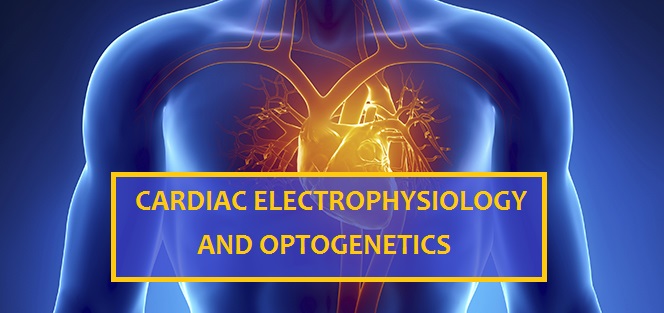
In this issue:

Feature: Cardiac Electrophysiology and Optogenetics
One of the most exciting topics to be discussed at this year's Photonics West was the inclusion and enhancement of Optical imaging tools in biomedical fields like cardiology. Emilia Entcheva, professor of biomedical engineering at George Washington University, walked the audience through her group's work in cardiac optogenetics, a new framework for the study of cardiac electrophysiology and arrhythmias. Their goal is to use optogenetic sensors and actuators to achieve high throughput, all-optical cardiac electrophysiology for applications in drug development (cardiotoxicity screen), drug discovery, and patient-specific therapies via the functional characterization of stem-cell derived heart micro tissues.
Her group has developed OptoDyCE, a fully automated system for all-optical cardiac electrophysiology. The device is the first high-throughput cardiac optogenetic system that can do this, according to Entcheva, and it has the potential to process 600 independent multi-cellular tissue samples per hour and more than 10,000 compounds per day. OptoDyCE can rule out potentially dangerous drugs by testing 30,000 light-responsive cells in less than 10 min, a process that currently takes hours or even years.
The technique streamlines the primarily manual process that researchers use to comply with FDA testing requirements and ensure the safety of the drugs. It can also be done using a patient's own blood cells using stem-cell techniques. One of the biggest challenges with developing new medications is testing to make sure treating the problem doesn't cause any cardiac toxicity, says Entcheva.
The GW team reported validation of optical actuation by virally introducing optogenetic drivers in rat and human cardiomyocytes, or through the modular use of dedicated light-sensitive somatic "spark" cells. The optical stimulation and recording method offers noncontact, dynamic control of millions of cells, the researchers said. "This not only allows you to perform faster testing but also provides a safer way to do measurements if you're testing hazardous materials," said the study's first author, doctoral student Aleks Klimas.
Separate from uses in the drug discovery arena, the method could also be used to confirm that stem cells have properly matured into heart cells, which could improve the quality of newly created heart cells and speed up their deployment in the clinic.
The team is now exploring the sensory input into the amygdala to determine what triggers predatory behaviors and investigating how the two modules--one controlling pursuit and the other controlling the kill--are coordinated.
The technology could appeal to pharmaceutical companies looking to expedite the drug development process, and Klimas hopes to commercialize the idea and develop a business to market the device.
Sources:
1. SPIE Newsroom Hot Topics, Kathy Kincade, Feb 2, 2017 Link
2. Optogenetic Technique Rapidly Screens for Cardiac Drug Safety. Photonics.com June 2016 Link
3. Nature Communications (doi: 10.1038/ncomms11542).
Laserglow in Research: Testing Implantable Cardiac Devices Using PIV
A joint project undertaken by researchers at Emory University, Georgia Institute of Technology and National Institutes of Health aims at developing a system to test the thrombogenicity of implantable cardiac devices. Thrombogenicity refers to the tendency of a material in contact with the blood to produce a thrombus, or clot. Laserglow's 532 nm DPSS LabSpec laser was used as an illumination source during the PIV portion of the project.
Prosthetic Heart Valves (PHVs) are a type of implantable cardiac devices that are known for thrombogenic complications. Although various in vitro systems have been designed to quantify blood-cell damage and platelet activation caused by hemodynamic shear stresses in these PHVs, very few systems attempt to characterize both blood damage and fluid dynamics aspects of PHVs in the same test system. The researchers present a small volume test platform which can be used for thrombogenicity studies and experimental fluid mechanics. A programmable piston pump drives blood into a cylindrical column, and can stimulate real life physiological conditions to test PHVs in vitro. The test was done with a mechanical heart valve in an aortic position. Blood damage was assessed using relevant assays, while fluid dynamics were characterized using time resolved Particle Image Velocimetry (PIV) using a blood mimicking fluid. The results of the test showed that the device setup produces consistent and repeatable result, and can prove to be a reliable and precise test of PHVs.
The researchers conclude that this tester should serve well in testing cardiac devices before proceeding into animal studies or clinical trials, at a fraction of the cost associated with such work. To learn more about the experimental setup, read the full paper at:
https://www.ncbi.nlm.nih.gov/pubmed/25587891
News: 'Zero-Loss' Material Could Improve Efficiency of Photonics
Engineers at the University of California San Diego have developed a material that could reduce signal losses in photonic devices. The advance has the potential to boost the efficiency of various light-based technologies including fiber optic communication systems, lasers and photovoltaics. The discovery addresses one of the biggest challenges in the field of photonics: minimizing loss of optical (signals in devices known as plasmonic metamaterials.
Plasmonic metamaterials are materials engineered at the nanoscale to control light in unusual ways. But a problem with metamaterials is that they typically contain metals that absorb energy from light and convert it into heat. As a result, part of the optical signal gets wasted, lowering the efficiency. In a recent study published in Nature Communications, a team of photonics researchers demonstrated a way to make up for these losses by incorporating into the metamaterial something that emits light-a semiconductor.
In their experiments, the researchers shined light from an infrared laser onto the metamaterial. They found that depending on which way the light is polarized, the metamaterial either reflects or emits light. "This is the first material that behaves simultaneously as a metal and a semiconductor. If light is polarized one way, the metamaterial reflects light like a metal, and when light is polarized the other way, the metamaterial absorbs and emits light of a different 'color' like a semiconductor," said Joseph Smalley, an electrical engineering postdoctoral scholar, and first author of the study.
Read more at: Phys.org full article